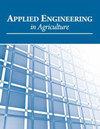风机频率对水产饲料带式干燥机气流分布及含水率的影响CFD模拟与实验验证
IF 0.8
4区 农林科学
Q4 AGRICULTURAL ENGINEERING
引用次数: 0
摘要
对带式干燥机中水产饲料干燥过程中的气流均匀性进行了scfd模拟研究。模拟结果较好地预测了干燥机不同进料层的气流分布。风机频率影响水分扩散率和整体干燥均匀性。风机频率为30 Hz时干燥效果最佳。干燥是水产饲料生产中的一个重要环节。带式干燥机广泛用于水产饲料的干燥。带式干燥机内部气流分布的均匀性影响着干燥产品的质量、干燥效率和能耗。风机频率是影响风机内部气流分布的关键因素之一。然而,对带式干燥机内部气流分布的研究并不充分,风速的准确测试具有挑战性。通过计算流体力学(CFD)仿真和实验验证,研究了25、30、35、40 Hz 4种不同风机频率下带式干燥机内部的气流分布。采用有限体积法对干燥机内部气流分布进行了模拟。为了提高计算结果的准确性,增加了多孔介质模型。结果表明,风速模拟值与实验值吻合较好。观测值与模拟值之间的最大差距为7.24%,最小差距小于0.1%。进料层的风速范围为0.34 ~ 1.10 m s-1,标准差可达0.17 m s-1。当风机频率为30 Hz时,进料层表面风速均匀性达到最佳。关键词:气流分布,带式干燥机,CFD,风机频率,多孔介质本文章由计算机程序翻译,如有差异,请以英文原文为准。
Effect of Fan Frequency on the Airflow Distribution and Moisture Content in Aquatic Feed Belt Dryer with CFD Simulation and Experimental Verification
HighlightsCFD simulation was done for studying airflow uniformity during drying of aquatic feed in a belt dryer.The simulation predicted the airflow distribution in different feed layers of the dryer well.The fan frequency affected the moisture diffusivity and overall drying uniformity.The fan frequency of 30 Hz resulted in the best drying process.Abstract. Drying is an essential process in the production of aquatic feed products. Belt dryer is widely used in drying aquatic feed. The uniformity of airflow distribution inside the belt dryer affects the quality of dried products, the dryer efficiency, and energy consumption. Fan frequency was one of the critical factors affecting air distribution inside the dryer. However, the internal airflow distribution inside the belt dryer was not fully investigated, and air velocities were challenging to test accurately. The airflow distribution inside a belt dryer at four different fan frequencies (25, 30, 35, and 40 Hz) was studied with computational fluid dynamics (CFD) simulation and experimental verification. A finite volume method was employed to simulate airflow distribution inside the dryer. The porous medium model was added to improve result accuracy. The results showed that the simulated value of air velocity was consistent with the experimental value. The maximum gap between observed and simulated values was 7.24%, and the minimum was less than 0.1%. The air velocity on the feed layer ranged from 0.34 to 1.10 m s-1 with a standard deviation of up to 0.17 m s-1. When the fan frequency was 30 Hz, air velocity uniformity on the feed layer surfaces could reach the best results. Keywords: Airflow distribution, Belt dryer, CFD, Fan frequency, Porous media.
求助全文
通过发布文献求助,成功后即可免费获取论文全文。
去求助
来源期刊

Applied Engineering in Agriculture
农林科学-农业工程
CiteScore
1.80
自引率
11.10%
发文量
69
审稿时长
6 months
期刊介绍:
This peer-reviewed journal publishes applications of engineering and technology research that address agricultural, food, and biological systems problems. Submissions must include results of practical experiences, tests, or trials presented in a manner and style that will allow easy adaptation by others; results of reviews or studies of installations or applications with substantially new or significant information not readily available in other refereed publications; or a description of successful methods of techniques of education, outreach, or technology transfer.
 求助内容:
求助内容: 应助结果提醒方式:
应助结果提醒方式:


